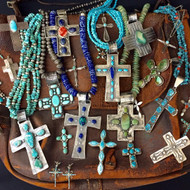Collector’s Corner - What Age is it?
Posted by Jim Olson on Nov 16th 2021
“I have this really old, antique, collectible __________ that I want to know how much it is worth,” she said.
“Oh yeah, how old?” was the reply.
“It’s at least from the 1970s!” She beamed proudly.
Folks bring items all the time to antiques and collectibles dealers and describe them as “antique” “old” “vintage” “historic” and so on. But just what do these terms really mean? And how do you determine which age category appropriately describes an item?
First, let’s start with recent items. “New” “Contemporary” and “Modern” are terms most of us understand. But for arguments sake, let’s put a date on them: they were made in the last 0 to 25 years. As we get to the later part of that date range, items are often just “used” or “out of date,” but in the interest of making a sale, the word “vintage” sounds better too many sellers. Vintage is often used on 20 to 25 year-old items, especially if the item is somehow nostalgic or desirable. However, the general rule is most items under 25 years old should not be considered all that old in the collectibles world.
That brings us to our next, and probably most thrown around term, which is “Vintage.” It is also a very ambiguous term because the definition literally means, “of age.” However, a generally accepted time (if you ask most knowledgeable collectors and dealers) for an item to start being called “vintage,” is no less than 25 years old (some say as much as 40). There is a bit of a gray area between 25 to 40 years. This is because some items are considered vintage at around 25 years while others—closer to 40. It has to do with what kind of an item is being referred to. For example, in the rapidly changing world of electronics, a computer from 25 years ago is definitely out-dated and considered “vintage.” Sometimes it also just depends on the person using the term, so it is good to know if they consider “vintage” as 25 years, or more? As mentioned, vintage is a little subjective as too when it starts.
Antique is a term thrown around (and often mis-used), but it is easy to define. By definition, this refers to an item which is at least 100 years old. So your (fill in the blank) made in the 1950s is not yet officially an antique. It should properly be referred to as vintage. An exception to the rule of an antique being an item which has reached 100 years of age, are “antique” firearms. As per the Bureau of Alcohol, Tobacco and Firearms (BATF) statute, an antique firearm was made in 1898 or before. But most other objects reach the destination at 100 years of age.
Going even further back, we have items from the “Historic” period. There can be varied definitions of a “historic period,” depending on what you are talking about. But with regards to collectibles, it refers to a period of time in the past which has been documented with written or other tangible information that can be verified. In the United States, we generally agree this period started about 1500 and went up through the 1800s. Some items (such as furniture) are still called “antiques” even though they may be from the historic period. But artifacts, for example, from the 1800s are often referred to as being a “historic period artifact.” However, once we reached the end of the Second Industrial Revolution (or about WWI), we entered into an era whereby things are either just antique, vintage or contemporary.
Before the historic period, we had the “Prehistoric” era. Prehistoric refers to a time before recorded (verifiable or written) facts are available in general. On the North American continent, this is pretty much during the 1400s or before. In Europe and other places it is much earlier as their recorded history goes back further. But an artifact from this period would generally be referred to as a “prehistoric artifact.”
One thing to be aware of is the word “style” used after any of the periods mentioned above. Many new items are made with an artificially aged look and sold as “retro style” “vintage style” with an “antiqued finish” etc.. Be careful, these terms should not be confused with the age of an item. They simply refer to a newer item made in the “style” of that period (sometimes also known as “retro”).
Another word which is good to know the definition of is “Artifact.” Folks often associate the word with age (as in a prehistoric artifact), but the actual meaning is: “An object (often a tool or an ornament) made by a human being (typically an item of archaeological, historical or cultural interest).” So artifacts could be antiques, or from the historic or prehistoric period, but the word by itself does not refer to a specific age.
Similarly used is the word “Relic.” Although originally meant to refer more to religious items, its modern usage is: “An object surviving from the past, especially one with historical or sentimental interest.” Again, the word should not be used to refer to a certain time period or age, as a “relic” could be an antique, or from the historic or prehistoric periods.
Below is a generally accepted timeline by antiques and collectibles dealers/collectors in North America of the various terms and an appropriate age range:
Modern or Contemporary: 25 years or newer.
Vintage: At least 25 (some say as much as 40) and up to 99 years old.
Antique: 100 years plus.
Historic Period: 1500s through 1800s.
Prehistoric Period: 1400s or before.
Jim Olson © 2021

